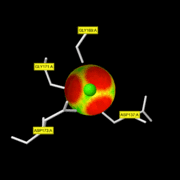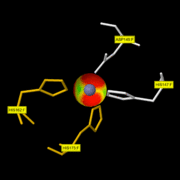Classification
EC 3.4.24.34
This classification means that this enzyme:
- is a hydrolase: it hydrolyzes covalent bonds
- is an endopeptidase: it cleaves peptide bond
- cleaves interstitial collagens in the triple helical domain (at a site about three-fourths away from the N-terminus)
The difference between this classification and EC 3.4.24.7 is that this enzyme cleaves type III collagen more slowly than type I.
To see
[1]
[2]
[2]
[3]
[4] pockets
[5]
Structure and domains
MMP8 is composed of several domains: a propeptide, a catalytic domain, a hinge region, and a C-terminal hemopexinlike domain.[3]
Thanks to X-ray crystallography, its structure has been solved with 1,7 Å resolution (2OY4).
Propeptide
It corresponds to , from Phe21 to Met100.
The sequence of residue is: FPVSSKEKNTKTVQDYLEKFYQLPSNQYQSTRKNGTNVIVEKLKEMQRFFGLNVTGKPNEETLDMMKKPRCGVPDSGGFM
Pocket interaction
Ca2+
This enzyme binds 3 Ca ions, 2 of them in the catalytic domain.
The residues involved in the Ca996 interactions (coordinate bonds) are .
Zn2+
Zn999
The Zn ion which is involved in the catalytic activity is the Zn999. In a publication [6] which studies the catalytic domain of MMP8 thanks to the Pro-Leu-Gly-hydroxylamine inhibitor, this ion is penta-coordinated with: His197, His201 and His207 of MMP8 and with the carbonyl and the hydroxyl oxygen of the hydroxamic acid moiety of the inhibitor. On this you can only see the 3 His of MMP8 with the Zn999.
Zn998
This ion is considered as a "structural" ion. The residues involved in the Zn998 interactions are . it's good to know that W Bode and al.[7] were unable to exchange or remove this Zinc in their crystals, which is suggesting that there is a tight interaction with MMP8.
maintain a Zn2+ atom coordinated with three water molecules. One of them is as well bound to the Glu residue thanks to a hydrogen bond. The second Zn2+ atom is not involved in the active site. At first, the Gly 206 residue of the substrate binds the active site thanks to the Zn2+ atom. When it binds it takes the place of unstable water molecules and establishes stabilizing interactions with the active site thanks to its C terminal part. Then, the Ala 182 residue of the enzyme makes a hydrogen bond with the NH group of the substrate: this allows the substrate to enter the cavity of the catalytic site. The rest of the protein is stabilized by 4 hydrogen bonds with the amino acid located in the cavity.
The conserved cysteine present in the cysteine-switch motif (89-96) binds the catalytic zinc ion, thus inhibiting the enzyme. The dissociation of the cysteine from the zinc ion upon the activation-peptide release activates the enzyme.
Catalytic domain
This domain is composed of 163 residues, from Met80 to Gly242, organized in and .
(http://www.ncbi.nlm.nih.gov/pmc/articles/PMC394940/?page=1). The catalytic zinc ion is situated at the bottom of the active-site. The other zinc ion and the two calcium ions are packed against the top of the beta sheet and presumably function to stabilize the catalytic domain. The polypeptide folding and in particular the zinc environment of the collagenase catalytic domain bear a close ressemblance to the astacins and the snake venom metalloproteinases.
The catalytic domain alone has proteolytic activity against other protein substrates and synthetic substrates.
Hemopexin domain
The hemopexin domain has two conserved cysteines that are disulfide bonded. Mutation of those cysteines to alanines [4] or reduction and alkylation destroys collagenolytic activity (K. Suzuki and H.Nagase, unpublished results).[3]
[8]
This domain is localized outside of the catalytic domain. It is essential for the substrate recognition of MMP-8 and the single catalytic domain of MMP-8 is not able to cleave collagen. When this hemopexin-like domain is removed, the protein loses its ability to cleave collagen. However, neutrophil collagenase is still able to cleave other substrate.
It seems that the collagen binds to two sites on MMP-8 : one in the catalytic site and another in the hemopexin domain. One hypothesis is that when the collagen binds to both sites, its helical structure is destabilized and unwound. Thus, the cleavage site of collagen is accessible and the cleavage reaction can occur.
Mechanism
To express collagenolytic activity, they have to retain both the catalytic and hemopexin domains.
It is not clear how the hemopexin domain help to cleave triple-helical collagens because the isolated hemopexin domains of MMP-8 does not bind to collagen.[5]
The binding of collagenases to collagen must partially unwind triple helix to allow cleavage of the individual alpha chains. Since heat-denatured collagens (gelatins) are poorer substrates at 37°C [6], interaction of collagenase to interstitial collagen must induce conformational change in alpha chain of collagen that fits the substrate binding site of the catalytic domain, but the molecular basis of this mechanism is not known.
In this model the peptide lies antiparallel to the edge strand IV by forming a number of hydrogen bonds. The N-terminal Pro at P3 (the third residue on the left of the scissile bond) interacts with the hydrophobic cleft formed by side chains of His162, Ser151, and Phe164, whereas Leu at P2 (the second residue on the right of the scissile bond) interacts with a shallow groove lined by His201, Ala206 and His207. The dominant interactions between the peptide and the enzyme are made by the phenyl side chain of the inhibitor and the large hydrophobic S1' pocket (located to the right of the catalytic zinc) formed by side chains of His197, Val194, Tyr219, and the main chain segment of Pro217-Asn-Tyr219. The side chain of P2� Ala points away from the enzyme and the C-terminal, P3� Gly is located crossover segments Gly158-Leu160 and Pro217-Tyr219.
Cleavage at Gly775–Ile776 or Leu776. [7]
Function
Like all the MMPs, MMP8 is secreted as inactive proproteins and then activated after a cleavage by extracellular proteinases. Indeed, it can't be activated without removal of the .
cleave the helical collagen molecule at a single Gly-Ile/Leu bond in each alpha-chain of the molecule. The cleavage generates fragments that spontaneously lose their helical conformation, denature to gelatin, and become soluble. The gelatin is then susceptible to attack by gelatinases and other proteases[8]
metalloendopeptidase activity = mechanism in which water acts as a nucleophile, one or two metal ions hold the water molecule in place, and charged amino acid side chains are ligands for the metal ions.[9]
Disease
Overexpression of MMP8, or inadequate control by TIMPs, can be associated with a lot of pathological conditions: psoriasis, sclerosis, osteoarthritis, rheumatoid arthritis, osteoporosis, Alzheimer's disease, tumor growh and metastasis.[10]
Neutrophil collagenase or collagenase 2 (MMP-8) is unique among the family of matrix metalloproteinases (MMPs) because of its exclusive pattern of expression in inflammatory conditions.[11]
Relevance
Structural highlights
This is a sample scene created with SAT to by Group, and another to make of the protein. You can make your own scenes on SAT starting from scratch or loading and editing one of these sample scenes.


